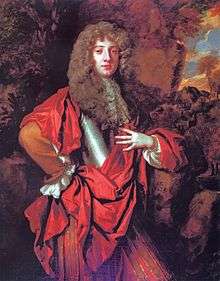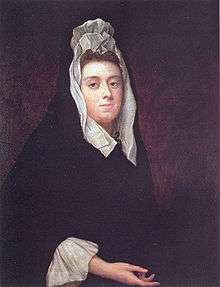Sir Thomas Grosvenor, 3rd Baronet
Sir Thomas Grosvenor, 3rd Baronet, born: 20 November 1656, died: 2 July 1700 (aged 43), was an English Member of Parliament, and an ancestor of the modern day Dukes of Westminster. He was the first member of the family to build a substantial house on the present site of Eaton Hall in Cheshire.
Sir Thomas Grosvenor, Bt | |
|---|---|
 Grosvenor in 1678 by Peter Lely | |
| Personal details | |
| Born | 20 November 1656 Eaton Hall, Cheshire, England |
| Died | 2 July 1700 (aged 43) |
| Resting place | St Mary's Church, Eccleston, Cheshire, England |
| Nationality | English |
| Political party | Tory |

Early life and education
Grosvenor was born at Eaton Hall, Cheshire, the son of Roger Grosvenor by his wife Christian (or Christine), daughter of Thomas Myddleton of Chirk Castle, Denbighshire.[1] He was less than five years old when his father, Roger, was killed in a duel with his cousin, Hugh Roberts, on 22 August 1661. Roger had been the son and heir of Sir Richard Grosvenor, 2nd Baronet, and therefore, Grosvenor succeeded to the baronetcy upon the death of his grandfather Sir Richard Grosvenor, 2nd Baronet on 31 January 1665. He was eight years old at that time.[1]
Grosvenor was educated by a private tutor, who also accompanied him when he undertook the Grand Tour, in his case, a three-year educational tour of France, Italy and the Levant, starting in 1670.[2] On his return, he set about building a new house at Eaton. At that time, the family house was a medieval moated house. The new house was the first substantial one to be built, and it was constructed to the north of the older house. Grosvenor appointed the architect William Samwell to design it, and building started in 1675. By 1683, over £1,000 (£144,000 as of 2015)[3] had been spent on the hall.[4] The money for this venture came partly from the estates, and also from coal and lead mines, and from stone quarries in north Wales, that were owned by the family.[1]
Public life
Grosvenor played his part in public life. In 1677, he was granted the freedom of Chester, and later the same year, he became an alderman. Two years later, he was returned as a Member of Parliament (MP) for Chester for the first time, in what became known as the Habeas Corpus Parliament; in all, he was to serve in six parliaments. In 1685, he became Mayor of Chester, and later that year, raised a troop of horses to support James II in the Monmouth Rebellion. Grosvenor served as Sheriff of Cheshire in 1688–89.[2]
Family
Grosvenor married in 1677; he was aged 21, and his wife, Mary Davies, was only 12 years old.[1] The marriage was arranged by their families in a manner and at an age which was quite normal in England in that era; it proved to be harmonious and conventional, and lasted all their lives. Mary was the daughter of Alexander Davies, a scrivener (scribe), and she had inherited substantial land to the west of London. This was part of the Manor of Ebury (previously Eia), and Mary's portion consisted of 'swampy meads' (marshland).[1] The area was later to become the Mayfair, Park Lane, and Belgravia areas of London; the most valuable parts of the Grosvenor Estate. The couple had three daughters and five sons. Two of the sons, Thomas and Roger, died young; the other three sons all succeeded in turn to the baronetcy, Richard became the 4th Baronet, Thomas the 5th, and Robert the 6th.[2]
Mary, Lady Grosvenor, had converted to Roman Catholicism shortly after coming of age.[1] Because of this, and because Eaton Hall was used as a meeting place for Catholics, Grosvenor's loyalty to the king was questioned.[2] However, he continued openly as an Anglican until his death in 1700, and he was buried in Eccleston church. Grosvenor's surviving sons were all under age at the time of his death; Sir Richard Myddelton, 3rd Baronet, and Thomas and Francis Cholmondeley were appointed as their guardians.[1]
Mary was buried in the churchyard of St. Margaret's Church, Westminster, where in 1892, her tomb was the only one to be seen there, close to the north porch of the church.[5]
 Coat of arms of the Grosvenor Baronets, of Eaton (1622)
Coat of arms of the Grosvenor Baronets, of Eaton (1622)- St Mary's Church, Eccleston – the enclosure which marks the site of the Grosvenor family vault within the demolished old church
- St Mary's Church, Eccleston – the tablet in the enclosure marking the site of the Grosvenor family vault within the old church
- St Mary's Church, Eccleston – the tablet in the new church which lists the Grosvenors buried in the demolished old church
References
- Newton, Diana; Lumby, Jonathan (2002). The Grosvenors of Eaton. Eccleston, Cheshire: Jennet Publications. pp. 8–12. ISBN 0-9543379-0-5.
- Handley, Stuart (2004) (online edition 2008) 'Grosvenor, Sir Thomas, third baronet (1655-1700)', Oxford Dictionary of National Biography, Oxford University Press, Retrieved on 6 April 2010. (subscription or UK public library membership required)
- UK Retail Price Index inflation figures are based on data from Clark, Gregory (2017). "The Annual RPI and Average Earnings for Britain, 1209 to Present (New Series)". MeasuringWorth. Retrieved 2 February 2020.
- Eaton Halls. Eaton Estate. 2002. p. 2.
- Smith, J.E., St John the Evangelist, Westminster: Parochial Memorials, Westminster, 1892, pp.355-362
External links
- Tedder, Henry Richard (1890). . Dictionary of National Biography. 23.
| Parliament of England | ||
|---|---|---|
| Preceded by Robert Werden William Williams |
Member of Parliament for Chester 1679–1681 With: William Williams |
Succeeded by William Williams Roger Whitley |
| Preceded by William Williams Roger Whitley |
Member of Parliament for Chester 1685–1689 With: Robert Werden |
Succeeded by Roger Whitley George Mainwaring |
| Preceded by Roger Whitley George Mainwaring |
Member of Parliament for Chester 1690–1700 With: Sir Richard Levinge 1690–1695 Roger Whitley 1695–1698 Thomas Cowper 1698 Peter Shakerley 1698–1700 |
Succeeded by Peter Shakerley Sir Henry Bunbury, Bt |
| Baronetage of England | ||
| Preceded by Sir Richard Grosvenor, 2nd Baronet |
Baronet of Eaton 1665–1700 |
Succeeded by Sir Richard Grosvenor, 4th Baronet |